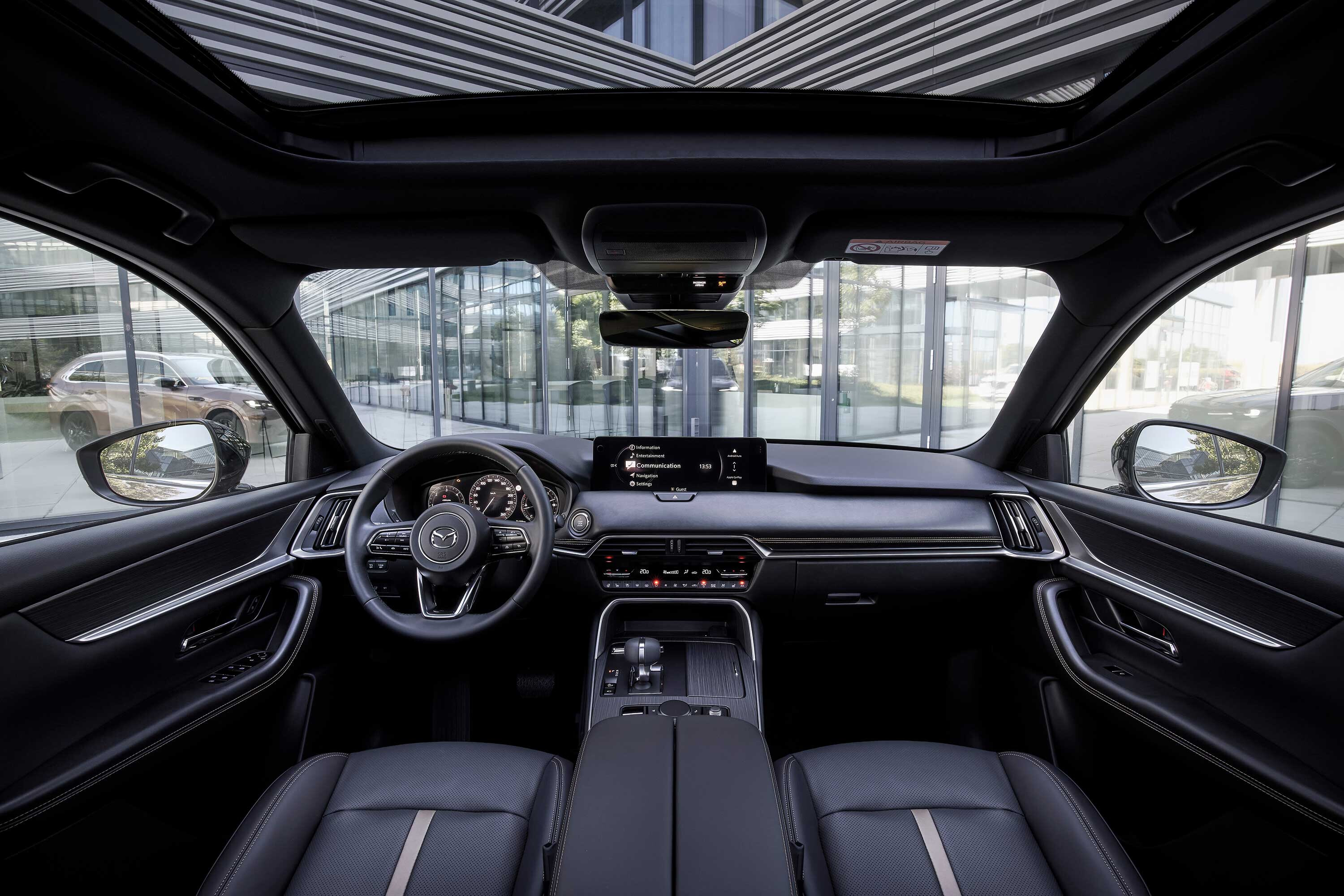Things we like
- Strong efficient engines
- Luxurious second row
- Spacious cabin all round
Not so much
- Improved ride still choppy
- Part-time touchscreen
- Nagging driver assists
October: 2025 Mazda CX-80 pricing revealed
New 2025 Mazda CX-80 arrives in Australia as the brand’s first hybrid-only seven-seat SUV
September: 2025 Mazda CX-80 first drive
Note: This review was published before Australian pricing was known, and remains unchanged.
When Mazda announced a major venture into a rear-drive-biased large vehicle platform powered by big straight-six combustion engines it was such a tangential departure from rival development programs that many wondered what Mazda had been putting on its cornflakes.
At about the same time, competitor brands in Japan and Europe were gearing up for electrification, big batteries in pure electric cars of all sizes, and downsized engines if not completely zero emissions powertrains, but then something unexpected happened. Instead of the uptake of electric vehicles continuing along the trajectory many predicted, a kink appeared in the graph.
Suddenly Mazda’s strategy to offer relatively large engines with varying degrees of hybridisation under bonnets of midsize and large SUVs didn’t seem such a harebrained idea.
Especially in Australia where EV sales are doubtless rapidly on the rise, but an apparent lag in infrastructure, incentives and interest is propping the sales of more traditional models for now – models like a big SUV with a six-cylinder engine.

This is the CX-80 – the third model to arrive in Australia and one of four SUVs planned for launch Down Under on Mazda’s new platform. It slots in alongside the existing CX-60 and largest CX-90 and will be joined by the CX-70 before long.
But let’s start with how they all fit in – concentrate please. As the discontinued CX-8 was essentially a narrower version of the also outgoing CX-9, you might expect the CX-80 to be the CX-90’s ectomorph sibling but, with the adoption of the new platform, the family relationships have changed.
Instead, the CX-80 is more closely related to the CX-60 with a longer wheelbase (and slightly taller height) to accommodate three rows of seating, while the CX-70 and CX-90 have the same exterior dimensions with five and seven seats respectively.
Confused? It’s explained by the designated market. The larger CX-70 and CX-90 will be sold in the USA, while the CX-60 and CX-80 are predominantly destined for the Japanese and European markets where the relationship between just two models is easier to understand. Australia, on the other hand, is taking all four. Now that you’ve completed the range familiarisation course, let’s look at what the latest model in the family has to offer.
Like its CX-60 stablemate, three powertrains will be on offer when the CX-80 arrives at the end of 2024 including a 3.3-litre straight-six turbo petrol and a diesel of the same configuration.
Pricing is yet to be confirmed but the inside line is that the petrol will be the most affordable version kicking off from just under $60,000. Above that, the diesel will attract about a $2000 premium while the third option is predicted to be the most popular, despite attracting about another $10,000 on top of that.
With a 17.8kWh lithium ion battery, the CX-80 2.5 e-Skyactiv PHEV weaves a 129kW/270Nm electric motor into the eight-speed automatic transmission and bolts it all to a 2.5-litre petrol four-cylinder.
The result is 241kW and 500Nm or, if you’re feeling green, the ability to go about 60km without firing up the engine at all. Perhaps unsurprisingly, the diesel is still as impressive as when we tested it under the bonnet of the CX-60.
It’s smooth, efficient, responsive thanks in part to its 48-volt hybridisation, and delivers meaningful performance with a pleasant note. The plug-in is even more impressive with strong acceleration from a standing start and in-gear alike, while even the electric-only driving mode has reasonable performance.

Unlike some other PHEVs, the CX-80 likes to stay in pure electric mode unless really prodded. It’s also very efficient with a claimed 1.6L/100km when setting out with a full battery but with the charge running low, its ability to behave like a mild hybrid we noted an average economy figure of about 6.7 litres per 100km – not bad for an SUV weighing nearly 2.2 tonnes.
Nor is the claimed acceleration time of zero to 100km/h in 6.8 seconds. There’s plenty of safety stuff too including adaptive cruise control with unresponsive driver assistance, emergency lane-keep assistance with head-on collision avoidance, advanced AEB with pedestrian/cyclist detection, extra protection for high-voltage system components, and 360-degree manoeuvring camera.
All good features to have just in case, but the numerous driver assistance systems were a little too chatty and eager to intervene with audible warnings.
With 20-inch wheels and premium paint on the outside, and a range of pointy end optional interior trims on the inside, our test cars were as premium as the CX-80 gets including the dark-theme Homura cabin styling which brings excellent dark leather upholstery and pleasant materials covering everything.
But there are touches common to all CX-80s that will enable every variant to feel a bit special.
A digital 12.3-inch instrument cluster is sharp and graphically attractive, while the same sized central touchscreen also looks good. Its operating system has been updated and is noticeably faster but its reskin is thin enough to see an essentially aged graphical design beneath.
Also, the screen is only touch-sensitive when using Android Auto or Apple Carplay. A shame because features such as the excellent hybrid navigation is a pain to use with the central rotary dial.

There’s better news in the second row where a pair of optional captain’s chairs duplicate the front seat comfort with a central console with arm rests and more storage.
Both the three-seat bench and more luxurious two-seat option allow the seats to be rolled forward and back 120mm offering heaps of legroom for second row occupants or more space to be donated to those in the back. Unfortunately we wont get the version missing the console which enables occupants to ‘walk’ through to the third row.
In the very back stalls, you wont find a pair of seats quite as accommodating as the CX-90 but it’s alright for shorter trips with USB-C charging on both sides, cup holders and more nice upholstery.
And if carrying stuff is more of a regular occurrence than people, the CX-80’s extended wheelbase and resulting boosted cabin volume will appeal too.
Even with all three rows of seats in place there’s still a 258-litre boot with power-operated tailgate, 687 litres with the third row easily stowed away and if the conventional second-row bench is folded the CX-80 load area increases to 1971L – although it’s not clear if this is still possible with the chunkier captain’s chairs arrangement.
But the elephant in the room here is the chassis which, if simply a re-run of the initial CX-60 and CX-90 tuning, would miss an opportunity to be significantly better.
In the CX-90 it was a little taut at best, but downright boneshaking in the CX-60. Thankfully, Mazda is positively receptive to criticism and the CX-80 has a revised suspension setup and improved ride.
Compared with the CX-60, Mazda has removed the rear anti-roll bar, softened the springs and firmed up the dampers – and it’s had the right effect. When at the wheel of the diesel, there’s still a choppiness to the secondary ride over manhole covers and road damage, but the behaviour when encountering larger bumps is certainly more composed.
It gets even better in the plug-in, in which the heavier mass appears to work better with the new spring rates for the best ride in any of Mazda’s large platform models yet.

Of course, all of this suspension fettling is likely to have had an impact on the sharp, sporty handling and body control demonstrated by the CX-60 and CX-90 – which was in some way compensation for the overly stiff ride.
Unfortunately we can’t comprehensively report back as the drive routes provided by Mazda on the International launch comprised almost exclusively of arrow-straight autobahns and mildly sweeping country roads. Great for establishing the improved comfort but just as effective at concealing any reduction in dynamic ability.
In the handful of tighter turns (found only through an unplanned detour, we might add) suggest there’s now noticeably more body roll. But if that’s the price to pay for boosted cabin comfort we still think that’s a step in the right direction.
There’s also less effort required to turn the steering in loaded corners but this again, suits the nature of a tall SUV without harming its precision.
With a more manageable width than the flagship CX-90 but just as many seats and a big boot, the CX-80 is a sweet-spot kind of SUV if you can live with the less satisfying proportions. But it also has the widest range of drivetrain options, none of which feel like a dud choice, and while the PHEV is a pricey proposition, it is efficient even offering the chance to never pay for fuel again if you have your home-charging electrical infrastructure in order.
With the changes to its suspension settings, the CX-80 is the clear pick in the Mazda new-gen SUV range and a compelling rival to the Hyundai Santa Fe and Toyota Kluger for example. But has it arrived late to this party? Mazda Australia managing director Vinesh Bhindi certainly doesn’t think so.
“When you look at consumer buying preference, not much has changed apart from clear evidence that hybrid is where the comfort factor is,” he said. “Eventually they’ll hopefully move to battery but that’s yet to be seen. Although there’s a lot more pure battery electric products, the pulse is not showing on the sales numbers so far.”
That sentiment depends how you look at it. More than 50,000 EV sales in the first half of 2024 represented an 18.0-percent increase and 8.0 percent of the market, while combined sales of hybrid and plug-ins totaled 89,863 which is more… but not that much more.
There’s a chance Mazda has committed a significant investment to swansong technology and is in danger of being overtaken by those brands that pumped cash into full electric long ago, but humans are inherently resistant to change.
Gradual shifts in the status quo are generally more tenable. If that also applies to the transition to electric vehicles then Mazda has its strategy sorted with a whole family of genuinely posh SUVs with the option of both mild hybrid and a more serious PHEV. The answer ultimately comes down to timing, and time will tell.
| Mazda CX-80 2.5 e-Skyactiv PHEV specifications | |
| Engine | 2488cc 4-cyl plug-in hybrid |
| Max power | 241 kW @ 6000rpm |
| Max torque | 500Nm @ 4000rpm |
| Transmission | 8-speed automatic |
| Weight | 2173kg |
| Economy | 1.6L/100km (8.1 L/100km with empty battery) |
| 0-100km/h | 6.7s |
| Price | $59,000 (estimated) |
| On sale | Q4 2024 |
Things we like
- Strong efficient engines
- Luxurious second row
- Spacious cabin all round
Not so much
- Improved ride still choppy
- Part-time touchscreen
- Nagging driver assists
We recommend
-
 News
News2025 Mazda CX-80 7-seat SUV revealed, Australia confirmed
The Mazda CX-80 – a stretched take on the CX-60 with six or seven seats – is due in Australia in late 2024 as the final model in the brand’s rear-biased SUV quartet
-
 News
NewsNew Mazda models coming: CX-5, CX-70, CX-80, EZ-6, RX-7 & more
Your guide to what's around the corner for Mazda Australia in 2024, 2025 and beyond... plus some potential additions yet to be confirmed
-
 Reviews
Reviews2023 Mazda CX-60 review: Australian launch
It’s a Mazda unlike any other, but is the CX-60 worthy of the brand's ambitious upmarket foray?






